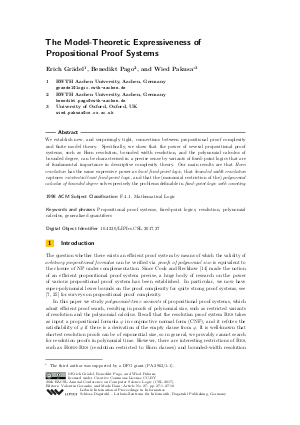The Model-Theoretic Expressiveness of Propositional Proof Systems
Authors Erich Grädel, Benedikt Pago, Wied Pakusa
-
Part of:
Volume:
26th EACSL Annual Conference on Computer Science Logic (CSL 2017)
Part of: Series: Leibniz International Proceedings in Informatics (LIPIcs)
Part of: Conference: Computer Science Logic (CSL) - License:
 Creative Commons Attribution 3.0 Unported license
Creative Commons Attribution 3.0 Unported license
- Publication Date: 2017-08-16
File

PDF
LIPIcs.CSL.2017.27.pdf
- Filesize: 0.53 MB
- 18 pages
Document Identifiers
Subject Classification
Keywords
- Propositional proof systems
- fixed-point logics
- resolution
- polynomial calculus
- generalized quantifiers
Metrics
- Access Statistics
-
Total Accesses (updated on a weekly basis)
0Document
0Metadata
Abstract
We establish new, and surprisingly tight, connections between propositional proof complexity and finite model theory. Specifically, we show that the power of several propositional proof systems, such as Horn resolution, bounded width resolution, and the polynomial calculus of bounded degree, can be characterised in a precise sense by variants of fixed-point logics that are of fundamental importance in descriptive complexity theory. Our main results are that Horn resolution has the same expressive power as least fixed-point logic, that bounded width resolution captures existential least fixed-point logic, and that the (monomial restriction of the) polynomial calculus of bounded degree solves precisely the problems definable in fixed-point logic with counting.
Cite As Get BibTex
Erich Grädel, Benedikt Pago, and Wied Pakusa. The Model-Theoretic Expressiveness of Propositional Proof Systems. In 26th EACSL Annual Conference on Computer Science Logic (CSL 2017). Leibniz International Proceedings in Informatics (LIPIcs), Volume 82, pp. 27:1-27:18, Schloss Dagstuhl – Leibniz-Zentrum für Informatik (2017)
https://doi.org/10.4230/LIPIcs.CSL.2017.27
BibTex
@InProceedings{gradel_et_al:LIPIcs.CSL.2017.27,
author = {Gr\"{a}del, Erich and Pago, Benedikt and Pakusa, Wied},
title = {{The Model-Theoretic Expressiveness of Propositional Proof Systems}},
booktitle = {26th EACSL Annual Conference on Computer Science Logic (CSL 2017)},
pages = {27:1--27:18},
series = {Leibniz International Proceedings in Informatics (LIPIcs)},
ISBN = {978-3-95977-045-3},
ISSN = {1868-8969},
year = {2017},
volume = {82},
editor = {Goranko, Valentin and Dam, Mads},
publisher = {Schloss Dagstuhl -- Leibniz-Zentrum f{\"u}r Informatik},
address = {Dagstuhl, Germany},
URL = {https://drops.dagstuhl.de/entities/document/10.4230/LIPIcs.CSL.2017.27},
URN = {urn:nbn:de:0030-drops-76897},
doi = {10.4230/LIPIcs.CSL.2017.27},
annote = {Keywords: Propositional proof systems, fixed-point logics, resolution, polynomial calculus, generalized quantifiers}
}
Author Details
References
-
M. Anderson and A. Dawar. On symmetric circuits and fixed-point logics. In STACS 2014, pages 41-52, 2014.

-
A. Atserias. On sufficient conditions for unsatisfiability of random formulas. J. ACM, 51(2):281-311, 2004.

-
A. Atserias, A. Bulatov, and A. Dawar. Affine systems of equations and counting infinitary logic. Theoretical Computer Science, 410:1666-1683, 2009.

-
A. Atserias and V. Dalmau. A combinatorial characterization of resolution width. Journal of Computer and System Sciences, 74(3):323-334, 2008.

-
A. Atserias and E. N. Maneva. Sherali-adams relaxations and indistinguishability in counting logics. In Shafi Goldwasser, editor, Innovations in Theoretical Computer Science 2012, Cambridge, MA, USA, January 8-10, 2012, pages 367-379. ACM, 2012.

- L. Babai. Graph isomorphism in quasipolynomial time. CoRR, abs/1512.03547, 2015. URL: http://arxiv.org/abs/1512.03547.
-
P. Beame and T. Pitassi. Propositional Proof Complexity: Past, Present, and Future. Current Trends in TCS: Entering the 21st Century, pages 42-70, 2001.

-
E. Ben-Sasson and A. Wigderson. Short proofs are narrow - resolution made simple. J. ACM, 48(2):149-169, 2001.

-
C. Berkholz and M. Grohe. Limitations of algebraic approaches to graph isomorphism testing. In Proceedings of ICALP 2015, pages 155-166, 2015.

-
C. Berkholz and M. Grohe. Linear diophantine equations, group csps, and graph isomorphism. In Proceedings of SODA 2017, pages 327-339, 2017.

-
J. Cai, M. Fürer, and N. Immerman. An optimal lower bound on the number of variables for graph identification. Combinatorica, 12(4):389-410, 1992.

-
C. Calude, S. Jain, B. Khoussainov, W. Li, and F. Stephan. Deciding parity games in quasipolynomial time. In STOC 2017, 2017.

-
M. Clegg, J. Edmonds, and R. Impagliazzo. Using the Groebner Basis Algorithm to find Proofs of Unsatisfiability. In STOC 1996, pages 174-183, 1996.

-
S. Cook and R. Reckhow. The relative efficiency of propositional proof systems. J. Symbolic Logic, 44:36-50, 1979.

-
A. Dawar. The nature and power of fixed-point logic with counting. ACM SIGLOG News, 2(1):8-21, 2015.

-
A. Dawar and E. Grädel. The descriptive complexity of parity games. In Proceedings of CSL 2008, pages 354-368, 2008.

-
A. Dawar, M. Grohe, B. Holm, and B. Laubner. Logics with rank operators. In LICS 2009, pages 113-122, 2009.

-
A. Dawar and P. Wang. Lasserre lower bounds and definability of semidefinite programming. CoRR, abs/1602.05409, 2016.

-
M. R. Garey, D. S. Johnson, and L. Stockmeyer. Some simplified NP-complete graph problems. Theoretical Computer Science, 1(3):237-267, 1976.

-
E. Grädel and S. Hegselmann. Counting in Team Semantics. In CSL 2016, 2016.

-
M. Grohe and M. Otto. Pebble games and linear equations. J. Symb. Log., 80(3):797-844, 2015.

-
P. N. Malkin. Sherali-adams relaxations of graph isomorphism polytopes. Discrete Optimization, 12:73-97, 2014.

-
M. Otto. Bounded Variable Logics and Counting. Springer, 1997.

-
W. Pakusa. Linear Equation Systems and the Search for a Logical Characterisation of Polynomial Time. PhD thesis, RWTH Aachen University, 2016.

-
N. Segerlind. The Complexity of Propositional Proofs. Bulletin of Symbolic Logic, 13(04):417-481, 2007.

-
J. Torán. On the resolution complexity of graph non-isomorphism. In Theory and Applications of Satisfiability Testing - SAT 2013, volume 7962 of LNCS, pages 52-66, 2013.

-
O. Verbitsky. On the dynamic width of the 3-colorability problem. CoRR, abs/1312.5937, 2013.

